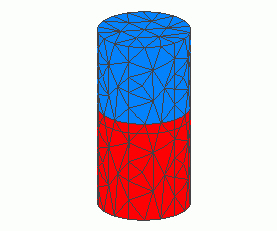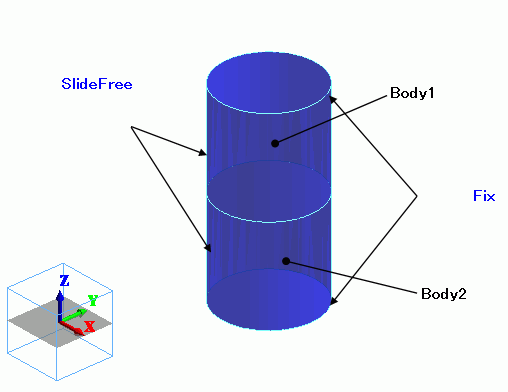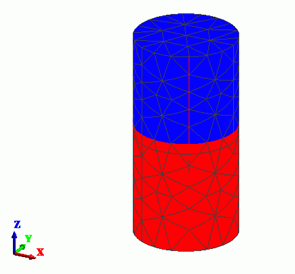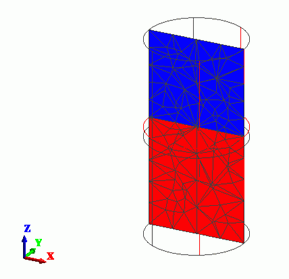
CAE Software【Femtet】Murata Software Co., Ltd.

Example25 Cylinder under Fixed Normal Displacement Subjected to Thermal Load

General
-
The model is a cylinder consisting of two different materials
Its normal displacement is fixed and subjected to the thermal load.
-
The deformation, the displacement and the mechanical stress are solved.
-
Unless specified in the list below, the default conditions will be applied.
Analysis Space
|
Item |
Settings |
|
Analysis Space |
3D |
|
Model unit |
mm |
Analysis Conditions
The temperature is applied evenly on the model.
Select Thermal load and set the reference temperature and the reached temperature.
There is no need to couple with the thermal analysis [Watt].
|
Item |
Settings |
|
Solvers |
Mechanical Stress Analysis [Galileo] |
|
Analysis Type |
Static analysis |
|
Options |
Select “Thermal load”. |
The Step/Thermal Load tab is set as follows.
|
Tab |
Setting Item |
Settings |
|
Step/Thermal Load |
Reference temperature |
0[deg] |
|
Step/Reached Temperature Setting |
Step 1: 300[deg] |
Model
The cylinder’s top and bottom faces are fixed in all directions. The side is fixed in normal displacement.
The upper and lower bodies have different coefficients of expansion.

Body Attributes and Materials
|
Body Number/Type |
Body Attribute Name |
Material Name |
|
0/Solid |
Body1 |
Mat1 |
|
1/Solid |
Body2 |
Mat2 |
The material properties are set up as follows:
|
Material Name |
Tab |
Properties |
|
Mat1 |
Coefficient of Expansion |
0x10^-6[1/deg] |
|
Elasticity |
Young’s modulus: 1×10^9[Pa] Poisson’s ratio: 0.3 |
|
|
Mat2 |
Coefficient of Expansion |
400×10^-6[1/deg] |
|
Elasticity |
Young’s modulus: 1×10^9[Pa] Poisson’s ratio: 0.3 |
Boundary Conditions
|
Boundary Condition Name/Topology |
Tab |
Boundary Condition Type |
Settings |
|
Fix/Face |
Mechanical |
Displacement |
Select all X/Y/Z components. UX=0, UY=0, UZ=0 |
|
SlideFree/Face |
Mechanical |
Normal displacement |
0.0×10^-3[m] |
Results
The displacement diagram is shown below. The scale adjustment is “same scale”

Body2 is pushing up Body1.
The section at XZ plane is shown below.

The border has been moved upward translationally.

